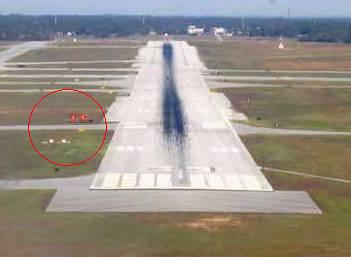Most people, both pilots and passengers alike, will judge the flying skills of a pilot based on how smoothly they can put the aircraft down on landing.
Performing the perfect landing starts off by making a perfect approach.
Making a perfect approach can be made much easier by taking advantage of everything installed at the airport to help you, including visual glideslope indicators.
Related Article – 14 Taxiway Markings, Signs, and Lights Explained By A Pilot
1. What are Visual Glideslope Indicators?
Visual glideslope indicators are installed at some airports to provide the pilot with vertical guidance down to the runway.
While the runway centerline is great at providing the lateral guidance needed to keep you landing in the middle of the runway, it does not tell you how high you should be.
Sure, you may not need any help with vertical guidance.
If you routinely fly the same airplane into the same airports it is easy to get accustomed to a specific sight picture and nail your altitudes without any extra help.
If you are flying a new airplane with a different cockpit view, flying into an unfamiliar airport, flying in reduced visibility due to weather or landing at night you will quickly learn to appreciate visual glideslope indicators.
They are a great way to help you overcome several types of visual illusions and put you at a perfect altitude to make textbook landings.
2. What are the different types of Visual Glideslope Indicators?
There are several different types of glideslope indicators and they all work on the same principal.
Basically, lights are mounted on the ground and angled towards the approach path of an aircraft coming in on final approach.
A continuous beam of light is projected from a lighting fixture that will change color depending on what angle you view the light from.
We call these lighting fixtures different things based upon how the lights are arranged.
The two systems that you will primarily encounter are the VASI (Visual Approach Slope Indicator) and PAPI (Performance Approach Path Indicator).
Before we talk about the differences, let us talk about the similarities (as noted in the Aeronautical Information Manual, Chapter 2)
- Both can be seen from about 3-5 miles during the day or up to 20 miles at night (although the PAPI will more consistently hit the high end of that range).
- Both will provide safe obstruction clearance within plus or minus 10 degrees of the runway centerline extending out at least 3 miles from the threshold (3.4 for PAPI and 4 for VASI, to be exact)
- Both will typically bring you down to the runway aiming point at an angle of 3 degrees, which is a standard glidepath.
- Both will also display all red lights if you are too low and all white lights if you are too high.
- Both also typically consist of 4 light fixtures, located to the left side of a runway.
Now we can start analyzing some of the differences. We’ll start with the PAPI since it is the superior product.
3. How does the Precision Approach Path Indicator (PAPI) work?
The PAPI consists of four light fixtures on a single wingbar, usually located to left of the runway approximately 1000 feet past the threshold.
Some large airports will have a PAPI installation on each side of the runway.
If you are on glideslope, the two outer lights of each unit are white and the two inner lights are red.
If you are slightly high, the three outer lights will be white and the innermost light will be red.
If you are slightly low, you will have one white light and three red lights. Too high (As in above 3.5 degrees) you will have all white.
Too low (less than 2.5 degrees) will indicate all red.

4. How does a Visual Approach Slope Indicator (VASI) work?
I referred to the PAPI as a superior product because having all of the lights attached to a single wingbar simplifies the installation process and reduces the cost.
This is one reason PAPIs are replacing VASIs. VASI’s will have at least two light bars.
A typical VASI installation will consist of a wingbar located 500 feet down the runway and another located 1000 feet down the runway.
If you are on glide slope the far lights will appear red and the inner lights will appear white.
All red indicates too low and all white indicates too high.
Many pilots use mnemonics such as “Red over Red means you’re dead” and “Red over white, you’re alright” to remind them of what to look for.
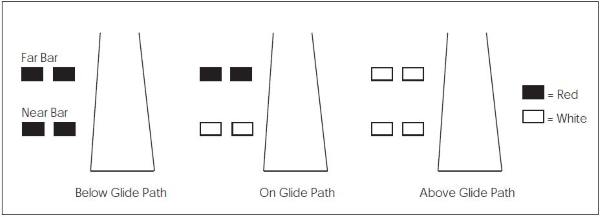
I personally just remember that I never want to see all of the same color!
If you see all red you are too low and risk Controlled Flight into Terrain.
If you are too high you risk landing long and running off the end of the runway. You want to see Red over White.
You’ll never see white over red (Unless the VASI is broken!)
5. What is a three bar Visual Approach Slope Indicator?
Keep in mind that the lights display a continuous beam of light that never changes.
What you personally see changes depending on the angle you view the lights from.
This could be problematic since the angle of the light beam is being interpreted by your eyes and not the landing gear of your aircraft.
In a small single-engine plane your eyes are only a few feet above the landing gear which will not make a difference in approach angle.
On some large aircraft, the pilot’s eyes may be sitting up much higher than the landing gear on the approach path.
To overcome this, airports capable of hosting large aircraft will need to use a PAPI or a three-bar VASI.
A three-bar VASI has an additional bar at the far end, intended to assist the pilots of the larger aircraft.
They focus on the middle bar and the far bar while ignoring the innermost bar.
Pilots of smaller airplanes will ignore the furthest light bar and focus on the inner and middle light bars.
PAPI lights are centrally located in the touchdown zone directly next to each other, allowing all pilots to use the same lightbar.

6. How large can a Visual Approach Slope Indicator be?
As noted in the AIM, most VASI installations consist of 2 bars, near and far, and consist of 2, 4 or 12 light units.
Occasionally VASI installations will consist of up to 16 lights! VASI installations of 2, 4 or 6 lights are located on the same side of the runway.
When the installation expands to 12 or 16 light units, the units are located on both sides of the runway.
This will usually be seen at large airports with lots of commercial traffic.
More lights increase visibility so pilots have a better chance of getting a visual on the airport runway environment when performing an IFR approach.

7. What is a Tri-Color Visual Approach Slope Indicator?
It’s worth mentioning- if for nothing else other than trivia, that we used to use some other variations of the VASI that allowed us to get all of our information from one single light!
Such examples of this would be a Tri-Color VASI (Visual Approach Slope Indicator) or a PVASI (Pulsating Visual Approach Slope Indicator).
I’m not going to spend much time discussing these because they are both extremely rare.
The Tri-Color VASI will display red if you are below the glidepath, green if you are on the glidepath and amber if you are above the glidepath.
The Tri-Color VASI has a couple pitfalls.
One downside is that you can see an amber light as you transition from red to green.
This can be very confusing because amber also is displayed when you are too high.
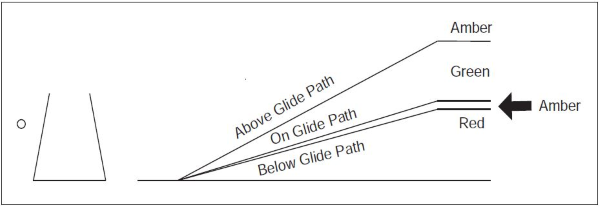
Additionally, having all of this information displayed by a single light fixture can make it easy to confuse this lighting aid with other lights at the airport.
8. What is a PVASI?
The FAA created a pulsating visual approach slope indicator (PVASI) to help differentiate this lighting aid from other lights at the airport.
You still got all of your information from a single light unit, but now it displays red if you are too low and pulsates white if you are too high.
It will alternate red/white or display a continuous white light if you are on glidepath.
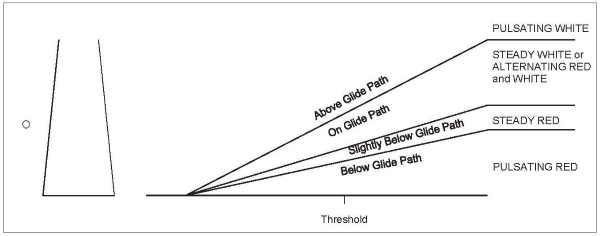
The PVASI quickly became obsolete and was replaced by the common designs we still use today.
I’ve never flown into an airport that had either a PVASI or Tri-Color VASI.
Some Final Takeaways
It’s worth noting that the lighting aids guide you to the aiming point of the touchdown zone and NOT the beginning of the runway.
If you prefer to land on the runway designator you will see the lights display all red as you allow yourself to dip below the glideslope.
I do not recommend doing that unless you can visually guarantee you are clear of all obstacles.
Also, Instrument rated pilots may notice that occasionally the PAPI/VASI will show them off the glide slope even though the ILS shows them on the glide slope.
This happens when the Visual Glideslope Indicator is and ILS glide path are not coincident.
When this occurs there will be a note in the bottom of the approach plate.
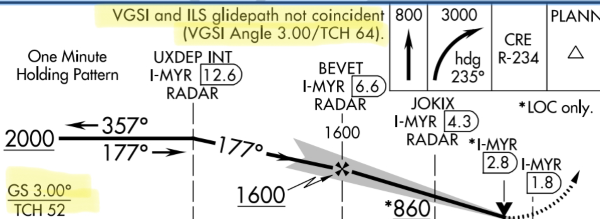
References:
FAR AIM, Chapter 2: https://www.faa.gov/air_traffic/publications/atpubs/aim_html/chap2_section_1.html

